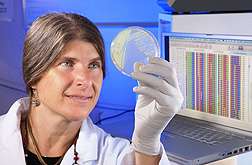Virus helps scientists identify 'who's who' among two veggie enemies

Natural warfare between a virus and a Pseudomonas bacterium is helping U.S. Department of Agriculture (USDA) scientists continue to learn about the bacterium's ability to kill arugula, broccoli, and several other cruciferous vegetables.
USDA plant pathologist Carolee T. Bull and her colleagues use the virus, known as PBSPCA1, as the basis for a lab test that helps quickly identify Pseudomonas cannabina pv. (pathovar) alisalensis. Bull works in the Agricultural Research Service (ARS) Crop Improvement and Protection Research Unit in Salinas, Calif. ARS is USDA's chief intramural scientific research agency.
In ongoing research that dates back to 1998, Bull and her co-investigators have detected and identified this pseudomonad; clarified its taxonomy, or "family tree"; and determined that it is the culprit behind a costly disease called bacterial blight of crucifers. The blight causes water-soaked spots to appear on plant leaves. Eventually, the spots coalesce and turn brown, giving the leaves an unattractive, burnt appearance that makes the vegetable unmarketable.
Early on, the scientists' field, greenhouse, and laboratory studies indicated that the crucifer blight bacterium could be easily confused with a close cousin, P. syringae pv. maculicola, which causes pepper spot disease. The two different pseudomonads kill some of the same vegetable crops, and several standard lab tests can't reliably tell which bacterium is which.
Bull and her colleagues chose the PBSPCA1 virus as the basis for a lab assay that reliably sorts out "who's who" among the two confusing bacteria. Because it can kill the crucifer blight bacterium, but not the pepper spot pseudomonad, the virus can be used to differentiate one from the other.
Bull and her coworkers begin using PBSPCA1 for preliminary diagnoses in 2002, and have continued to improve the assay.
The virus and both of the bacteria are harmless to humans.
The bacterium that the team was to later identify as the cause of crucifer blight began showing up in vegetable fields in California's Salinas Valley in 1995. Bull began investigating the mysterious microbe three years later. Within a few years, her team had resolved much of the confusion surrounding it.
Today, Bull and her co-investigators continue to help growers and plant pathologists in the United States and abroad identify the crucifer blight bacterium. Positive identification matters, especially when growers are deciding what to plant. For example, the Salinas studies have shown that broccoli, cabbage, and cauliflower are vulnerable to both the crucifer blight and the pepper spot bacteria, while some other crops, such as lettuce, are not.
Read more about this research in the February 2013 issue of Agricultural Research magazine.
Journal information: Agricultural Research
Provided by Agricultural Research Service


















